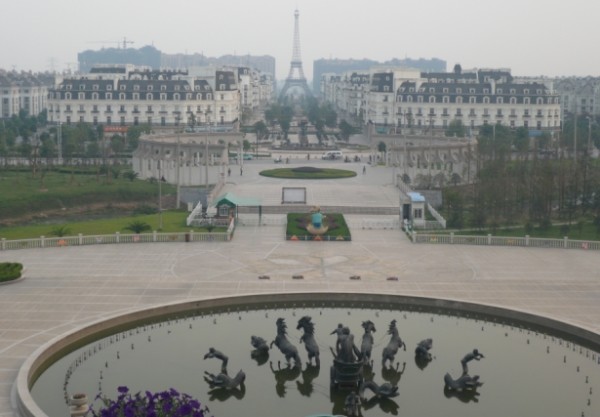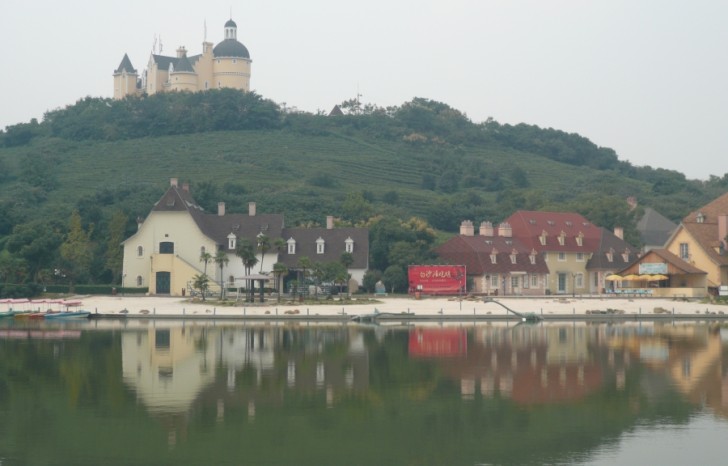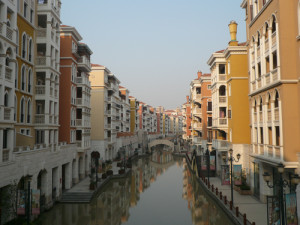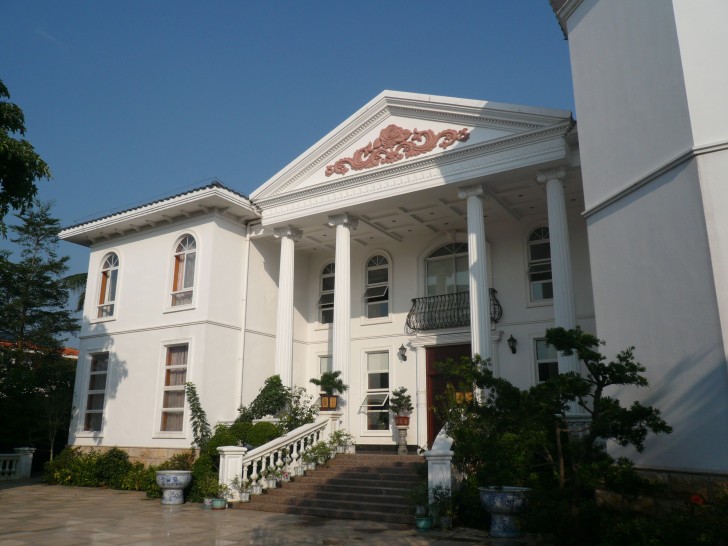The best knock-offs in the world are in China. There are plenty of fake designer handbags and Rolexes but China’s knock-offs go way beyond fashion. There are knock-off Apple stores that look so much like the real thing, some employees believe they are working in real Apple stores. And then there are entire knock-off cities.
There are Venices with complete canals and replicas of the Doge’s Palace. A Paris with an Eiffel Tower and an Arc de Triomphe. In the suburbs of any Chinese city, there are endless examples of “duplitecture.”

Shanghai alone has ten cities all built in the architectural styles of different European countries. Traffic permitting, it’s possible to travel from “Germany” to “Italy” to “England” in the course of a few hours.

These are not theme parks or novelties like one might see in Las Vegas. Duplitecture developments are functioning communities where Chinese families are raising their children and living their lives.
These communities also differ from American Chinatowns or Germantowns, which were established by immigrants. These are Chinese communities, in American- or European-styled buildings, designed primarily by Chinese architects.

These replica buildings resemble the originals to varying degrees. The buildings might be larger or smaller than the real thing. They might be made of different materials or even painted another color. As such, duplitecture can become a warped caricature of the original.

Developers take a lot of liberties with duplitecture construction, sometimes adjusting the replicas to work in accordance with the principles of Feng Shui.
Nevertheless, a lot of these duplitecture communities have rules to actively discourage any behavior that they think might ensure that the “European feel” of the development is not disrupted.
To further create the impression of a Paris, there might be a French bakery, or a Bastille Day celebration.

As odd and uncanny as these buildings and communities can be, duplitecture is pretty impressive. These buildings go up quickly, on a massive scale, and they show no signs of stopping. New developments are popping up around China all the time, even though duplitecture isn’t exactly a new trend.

In premodern China, imperial rulers used copycat buildings to show off their authority, making replicas of landmarks in cities they had conquered, or importing flora and fauna to recreate foreign landscapes within their own domain.
In keeping with that tradition, one of the most copied buildings in China is the very seat of western power itself: the White House. Serving as hotels, restaurants, courthouses and homes, White Houses are all over China, morphed and varied in different permutations. Still, they all have those signature columns and square portico.


Though some might argue that the Chinese have taken duplitecture to a whole new level, architects have been copying each other forever, and the U.S. is no exception. The architect who built the White House based his design on The Leinster House in Dublin, which is now the seat of the Irish parliament. The Leinster House, in turn, contains strong elements of Greek and Roman architecture.

Some of the greatest hits of American architecture are copies of the greatest hits of ancient Roman architecture, which are now all being copied by the Chinese. China has proven quite successful at turning imitation into innovation in other sectors. China’s iPhone knockoffs had some features that you couldn’t find on Apple’s phone, like removable battery and multiple sim cards, all for a lower price. It’s easy to scoff at a fake Venice, but copying, as a practice, is totally underrated. Mindful iteration is often how good things become great things.



Comments (14)
Share
Very surprised the writer did not connect Disney’s Epcot villages as the foundation influence of this trend.
Or how Walt Disney copied Children’s Fairyland in Oakland (and then Children’s Fairyland filled itself with knock off Disney stuff).
“Just like the White House had a china collection, China has a White House collection”
That made my day! Also, there’s a similar occurrence in the Middle East, as many countries import foreign designs (like Dubai).
I’m excited to check out Bosker’s book & maybe to one day stroll down a Champs-Élysées in a suburb of Shanghai… ^_^
FWIW i’d totally recommend people intrigued by this episode to read Marcus Boon’s In Praise of Copying [ http://www.hup.harvard.edu/features/in-praise-of-copying/ ]. It’s is a vertiginous but accessible exploration of some of the philosophical implications of these sorts of copies and translations and is [natürlich!] availble as a free pdf.
being a orange country resident (aka victim). I am really curious to what orange county duplitecture looks like in China.
Could it be that the Chinese care about traditional Western architecture more than we Westerners do? I’m afraid we’re knocking down our great heritage buildings faster than China can copy them.
I love the podcast, but this episode had so many sibilant “s” sounds that I had to stop it. Please check the mics or the processing or something. Roman sounded fine, but the other voices were grating.
Civic design – EPCOT itself is essentially a copy of the 1939 New York World’s Fair.
Really, 99% Invisible? A whitewash of shanzhai that fails to mention the economic costs of intellectual property theft and the human and societal costs of shoddy knock-offs?
Many of your listeners will have seen photographs of residential tower blocks (thankfully unoccupied) that have toppled over in southern China thanks to short piles (contractors saving money); they will have heard the many, many, many stories about toxic toys and infant formula that contained no nutrients and caused babies to starve to death.
There are so, so many stories, and if you dig deeper, you learn that there are serious cultural problems in China that mean every year China is at least SIX TIMES WORSE in terms of dangerous defects PER PRODUCT than any other country in the world.
That’s not an “everyone is doing it” issue. That’s a serious socio-cultural problem (that Chinese are better aware of than anyone, which drives insatiable demand for e.g. foreign baby formula).
Has anyone read Unreal America: Architecture and Illusion by Ada Louise Huxtable?
This story reminds me of Forbidden Gardens, a tourist attraction that was in Houston around 5 years ago or so. It’s was a scaled version of China’s Forbidden Palace compleat with its own Terracotta Army. Was really cool when I saw it back in the day.
Hi you guys. Knowing that some of you have Chicago roots, I thought you’d appreciate this:http://www.dnainfo.com/chicago/20150812/downtown/china-totally-ripped-off-chicagos-bean-sculpture-photo
I am floored by the replicas of Venice and Paris, they’re gorgeous! As a European I would love to visit the ”fake” versions, there would probably be way fewer tourists, and I’d love to try living in such a place. It takes real care and dedication to copy something so well.
I had no idea that Leinster House influenced the design of the White House! Another little piece of duplitecture happened in Dublin too, copying Leinstir House. The same architect who designed the House was asked to re-design the Rotunda Hospital in Dublin and used the exact same facade on it as Leinster House. Like, every detail the same. I always thought it was funny.